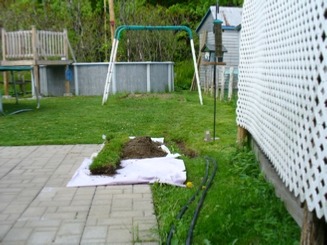



OTHERS





Click on images bellow to increase resolution
This is where the tubes arrive at the post. The first on the left side that goes up contain the two main lines for the Beverages and long wires. The second and third tube ends in that weatherproof plastic box there with K9AY line and control cable. From this point, there's a third tube going underground up to the K9AY (now dismantled) and finally at far right, a short tube was left for future use.
The feedpoint stands at that big post behind the swimming pool. There are two underground 3/4 inch plastic water tubing containing each one two cables. One with two RG6 coax cables and the other with one RG6 cable and one Ethernet 8 conductor cable for remote control purpose. This was a nasty job first burying and then, leaving everything clean after digging and filling back. From that same post, there's another underground cable run for around 8m (30ft) to the (former) K9AY antenna back into the bushes
The first thing you must know when purchasing the MFJ-
Another important detail you must know based on my personal experience and others too is that the potentiometers that MFJ puts in their product are really cheap stuff. After just a couple of months of use, the phase pot began to fail. My first reaction was to send to MFJ an email describing my situation and explaining that I could not send them under warranty because I did some mods on it. Anyhow, that problem has nothing to do with the mods and it would be kind from their part to send a new pot that I could replace myself. This is what they kindly did. After the new pot was installed, an input gain pot began to fail as well and even the new phase pot began to show weaknesses again! I then decided to replace them all with quality parts. I then ordered from Newark Canada three Honeywell Clarostat RV4 series potentiometers. They happen to fit perfectly to the 1026 chassis. To achieve the mod, you’ll need two RV4NAYSD251A for the gain controls and one RV4NAYSD102A for the phase control. They are even smoother than the original MFJ part and I can tell you that my modified phaser really gets the job done and this, year after year. See the Clarostat product datasheet here.
MFJ-
View of the new Clarostat potentiometers with input swap mod and grounding switches
View of the high-
Front view of the unit with extra switches
Internal view of one of my three splitters. I used the design described by the late John Bryant and Bill Bowers in this article. I made them from plastic small boxes for their availability and low price. At the beginning, I've left the primary and secondary windings isolated but after my lightning event , I had to connect them to a common ground to respect the grounding scheme. After that mod, I didn't notice any difference on the reception.


DX ENGINEERING RPA-
First, when I bought this preamp, I thought in using it near my K9AY loop in a weatherproof box to increase its overall gain. Then, when I elected to work mainly with the Beverages, I decided to keep it near my receiver and I can tell you that it will stay there. It all situations, the internal preamps of either the R75 or the Perseus don't match with the performance of the late DX Engineering RPA-
Note that the RPA-


I've added a new splitter to feed both Icom and Perseus receivers. I had a Radio Shack TV splitter in my junk box. After pulling out the original transformer, I just replaced it with the HF transformer as described above. Just another ready-
**Please, see the Noise page for an important update related to the RPA-


THE PC I'm using at my receiving station has been updated in 2020 for a Dell w an Intel I5 powered by Windows 10 and 12 GB of RAM. That is more than enough for King Perseus but near limit for the SDRPlay when capturing FMDX at a 10 MHz sample rate. Besides Jaguar Pro for MWDX, I'm using the freeware Audacity to record and edit some of the MP3 clips. French version of defunct software WebPlus (version X8) is still used to create this website. My actual digital camera is a Panasonic Lumix DMC-
COMPUTER AND RELATED

Page updated in August 2024

LEO BODNAR ELECTRONICS’ GPSDO


In order to get a reference signal for a precise MW frequency offset measurement, I acquired in June 2024 a Leo Bodnar Electronics Mini-
For good measure because of the wooden surface, I’ve added to the bracket, a plate of sheet metal behind the unit which act as an heatsink. This thing gets warm in a hurry.
| Receiving Station Setup |
| Receivers |
| Antennas |
| Line / Antenna switchers |
| Lightning protection |
| Others |
| Conventional receivers |
| Microtelecom Perseus |
| SDRPlay |
| Beverages |
| K9AY |
| PA0RDT Mini-Whip |
| Miscellaneous |
| Asian audio files |
| African audio files |
| European audio files |
| Middle-East audio files |
| Latin American-Caribbean audio files |
| 2015 St-Patrick' solar storm audio files |
| DX Curiosities |
| August 2007 bandscan |
| August 2014 bandscan |
| FMDX equipments |
| FM logs 2017-2018 |
| FM logs 2020 |
| FM logs 2021 |
| FM logs 2022 |
| FM logs 2023 |